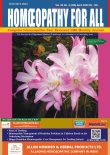Efficacy of Homeopathy in the Multiphase Management of Migraine
Keywords:
Homeopathic remedies, General Management, preventiveAbstract
Migraine is the sixth most disabling and the third most prevalent illness globally, affecting approximately 1 billion individuals.1 This neurological condition manifests as intense throbbing headaches often accompanied by nausea, vomiting, and sensitivity to light and sound. Such symptoms significantly impair quality of life, reducing productivity and increasing medical expenditure. In the U.S., about one in four people experiences migraines, with 18% of women, 6% of men, and 10% of children affected. In India, the prevalence of migraine is reported to be around 25% among women and 10% among men.2 Key triggers include stress, weather changes, exhaustion, certain foods and beverages, sleep disturbances, hunger, and hormonal fluctuations.3 Understanding these factors is crucial for effective management and prevention.
Downloads
References
Estemalik E, Tepper S. Preventive treatment in migraine and the new US guidelines. Neuropsychiatr Dis Treat 2013; 9:709–720
Indian Journal of Community Medicine (IJCM), Volume 45, Issue 3, 2020. "Prevalence of Migraine in India: A Population
Based Study".
Rossi, M. F., Tumminello, A., Marconi, M., Gualano, M. R., Santoro, P. E., Malorni, W., & Moscato, U. (2022). Sex and gender differences in migraines: a narrative review. Neurological sciences : official journal of the Italian Neurological Society and of the Italian Society of Clinical Neurophysiology, 43(9), 5729– 5734. https://doi.org/10.1007/ s10072-022-06178-6
Hansen JM, Schankin CJ. Cerebral hemodynamics in the different phases of migraine and cluster headache. Journal of Cerebral Blood Flow & Metabolism. 2019;39(4):595-609. doi:10.1177/0271678X17729783
Kelman, L. (2004). The premonitory symptoms
(prodrome): a tertiary care study of 893 migraineurs. Headache: The Journal of Head and Face Pain, 44(9), 865-872.
Petrusic I, Zidverc-Trajkov ic J, Podgorac A, Sternic N. Underestimated phenomena: Higher cortical dysfunctions during migraine aura. Cepha lalgia. 2013;33(10):861-867. doi:10.1177/0333102413476373
Graham, J. R., & Wolff, H. G. (1938). Mechanism of migraine headache and action of ergotamine tartrate. Archives of Neurology & Psychiatry, 39(4), 737-763.
Bose, P., & Goadsby, P. J. (2016). The migraine postdrome. Current opinion in neurology, 29(3), 299- 301.
Kent JT. Lectures on homoeopathic philosophy. Ehrhart et Karl; 1919.




